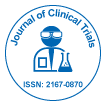
Journal of Clinical Trials
Open Access
ISSN: 2167-0870

ISSN: 2167-0870
Perspective - (2025)Volume 15, Issue 4
Dengue fever continues to affect millions globally, with children in endemic regions experiencing high rates of infection and severe disease manifestations. The development of a safe and effective dengue vaccine suitable for pediatric use has been a longstanding goal in public health. Current challenges include achieving balanced immunity against all four dengue virus serotypes and avoiding vaccine-induced enhancement of disease.
The trial was conducted in five sites located in regions with a known history of dengue transmission. A total of 820 healthy children were enrolled following screening and consent procedures. Participants were randomized in a 2:1 ratio to receive either two doses of the investigational vaccine or placebo, administered subcutaneously 90 days apart. The inclusion criteria required participants to be seronegative or seropositive for dengue based on baseline antibody testing and to have no acute illness at the time of enrollment.
The primary objective was to evaluate the vaccine's ability to elicit a neutralizing antibody response to all four dengue serotypes at 30 and 180 days after the second dose. Secondary objectives included assessing the safety profile, frequency of local and systemic adverse events and serotype-specific immunogenicity in both seronegative and seropositive children. Immunogenicity was measured using a micro-neutralization assay, while safety was monitored through clinical assessments, parental diaries and laboratory evaluations.
Results showed that the vaccine was highly immunogenic. At day 180 post-second dose, 91% of vaccinated participants had a tetravalent response, defined as neutralizing antibody titers above the protective threshold for all four dengue serotypes. Serotype-specific responses were slightly higher for DENV-1 and DENV-2, while DENV-4 showed slightly lower but acceptable titers. Children who were dengue-seropositive at baseline had stronger and more durable responses across all serotypes compared to those who were seronegative. Nevertheless, the vaccine was capable of inducing primary responses in seronegative children without evidence of increased reactogenicity.
The vaccine was well tolerated, with no serious vaccine-related adverse events reported. Local reactions such as injection site pain and redness were observed in 26% of vaccine recipients and 18% of placebo recipients, typically resolving within 48 hours. Fever, headache and fatigue were the most common systemic symptoms, occurring in fewer than 15% of participants and predominantly after the first dose. No hospitalizations due to adverse effects occurred during the trial period.
Follow-up laboratory parameters showed no clinically significant changes in liver enzymes, hematologic indices, or inflammatory markers in the vaccinated group compared to placebo. One transient drop in platelet count was observed in a vaccinated participant but resolved spontaneously without intervention. No instances of dengue-like illness occurred in the vaccinated group during the trial follow-up period.
An exploratory analysis compared immune responses by age subgroup. Children aged 2 to 5 years demonstrated slightly lower antibody titers than those aged 6 to 11 years, but the difference was not statistically significant. Both groups reached protective thresholds, suggesting that the vaccine performs consistently across the pediatric age range included in the study.
Parental feedback was overwhelmingly positive. More than 90% of parents whose children received the vaccine expressed willingness to participate in future booster studies. Satisfaction was attributed to clear communication, low incidence of side effects and the perceived protection from dengue illness. Parents of placebo recipients who remained unaware of their group allocation also expressed support for the study process and follow-up care.
The trial also explored the potential for co-administration with routine pediatric vaccines. A subset of 150 participants received scheduled childhood immunizations within one week of receiving the dengue vaccine or placebo. No interference in serologic response to routine vaccines was observed and adverse event profiles were similar to those receiving the dengue vaccine alone. These findings support potential integration of the dengue vaccine into existing immunization schedules, subject to further validation.
The observed tetravalent immune response is a key achievement given the historic challenges with other dengue vaccine candidates, some of which produced imbalanced responses that heightened the risk of breakthrough infections. The vaccine used in this study incorporated modifications to promote uniform antigen expression and attenuated replication for each serotype, potentially contributing to the balanced response seen here.
This study contributes valuable data on the safety and immunogenicity of a dengue vaccine designed for children, a population often underrepresented in early-phase vaccine trials. The ability to induce durable, balanced immunity with a favorable tolerability profile in young children holds promise for future public health implementation in endemic regions.
In conclusion, the investigational live-attenuated tetravalent dengue vaccine demonstrated strong immunogenicity and a reassuring safety profile in children aged 2 to 11 years. The high rate of seroconversion across all four dengue serotypes and the minimal incidence of adverse reactions support further evaluation in larger efficacy trials. Successful pediatric immunization against dengue could reduce disease burden, hospitalizations and the risk of severe outcomes in vulnerable populations. These results represent a meaningful step toward achieving effective dengue prevention in children through routine vaccination.
Citation: Kamal P (2025). Immunogenicity and Tolerability of a Novel Dengue Vaccine in Pediatric Populations. Clin Trials. 15:595.
Received: 06-Jun-2025, Manuscript No. JCTR-25-37924; Editor assigned: 09-Jun-2025, Pre QC No. JCTR-25-37924 (PQ); Reviewed: 23-Jun-2025, QC No. JCTR-25-37924; Revised: 30-Jun-2025, Manuscript No. JCTR-25-37924 (R); Published: 07-Jul-2025 , DOI: 10.35248/2167-0870.25.15.595
Copyright: © 2025 Kamal P. This is an open-access article distributed under the terms of the Creative Commons Attribution License, which permits unrestricted use, distribution and reproduction in any medium, provided the original author and source are credited.